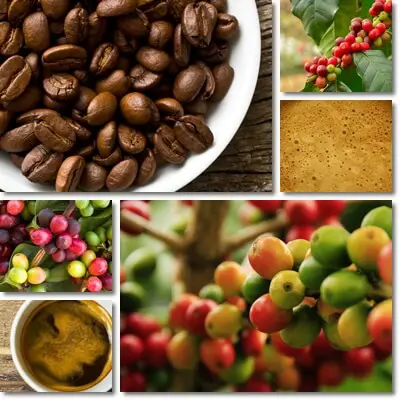Coffee is the iconic morning brew made from the plant with the same name. But what is coffee more exactly? What plant part is coffee made from? How is coffee made? What are coffee cherries? What do you call coffee grounds? What does coffee taste like? Is there any difference between the different types of coffee plants?
What is coffee?
By definition, coffee is a brew meaning a beverage obtained by brewing which is boiling or steeping something in water. Coffee also refers to the coffee plant, a flowering plant in the genus Coffea whose seeds are dried, roasted and finely ground and used to make the brew with the same name. Coffee can be consumed black, meaning just roasted and ground coffee beans brewed in water, or with dairy or non-dairy milk, heavy cream, whipped cream, sugar, honey, maple syrup, artificial sweeteners, soda and more.

What is coffee made of?
Coffee is made from seeds called coffee beans. Coffee beans, which are not real beans but botanical seeds, are separated from their fruit, dried, roasted and finely ground. The resulting material can then be used to make the beverage commonly called coffee. There are well over a hundred different species of the coffee plant grown around the world, the best known being Coffea arabica, Coffea robusta or Coffea canephora, Coffea liberica and Coffea eugenioides.
About the coffee plant
The coffee plant is the plant from which coffee is made. The scientific name for the coffee plant is Coffea which is the origin of the common name for both the plant and beverage. There are well over 100 different species of the coffee plant with numerous cultivars and hybrids. Botanically, the coffee plant is classified as a shrub or small tree because of how tall it grows. It is a flowering plant meaning it produces flowers or blossoms. Fruits develop from the flowers and produce seeds that are used to make the brew we commonly call coffee.
What is coffee cherry?
A coffee cherry is the fruit of the coffee plant, and it’s also called a coffee berry. It develops from coffee flowers. The fruit is called a (coffee) cherry because it looks somewhat like a cherry meaning it’s small and bright red to deep red when ripe and sweet, its appearance and, to a lesser extent, also taste, being reminiscent of a cherry. Despite the common name, the coffee cherry is not a botanical cherry, although it’s related to cherries. Coffee cherries are drupes or stone fruit like cherries, plums, apricots, peaches, nectarines, almonds, mangoes, olives, loquats, jujube fruit and coconut.

Can you eat coffee cherries?
Coffee fruit called coffee cherries, or coffee berries, develop from coffee plant flowers and are edible raw, cooked, juiced and otherwise processed. You can eat coffee cherries and they are both perfectly safe to eat and taste good. The fruit are ready to eat when they are ripe and turn bright to deep red, red purple, or even pink, orange or yellow.
What do coffee cherries taste like?
Coffee cherries taste sweet and fragrant, with pleasant fruity flavors reminiscent of mango and berries. A distinctive trait of the fruit is they naturally have caffeine, just like coffee beans.
What are coffee grounds?
Coffee grounds are the solid particles that settle at the bottom of brewed coffee. They are essentially the ground coffee beans material left over from making coffee. The sediment is also called ‘coffee dreg’ or ‘coffee dregs’. Coffee grounds may also refer to the actual coffee meaning the loose, roasted and ground coffee beans material.
How is coffee made?
Coffee fruit called cherries are picked from the coffee plant when ripe. They are either dried as they are, or the fruit skin and pulp are removed and the seeds inside (the coffee beans) are dried by themselves. Coffee beans can be air dried or dried using various machineries. The beans are then roasted to enhance their flavor, and usually also finely or more coarsely ground. The resulting dried, roasted and ground coffee beans material represents coffee.
How to make coffee
To make coffee, you heat up some water near the boiling point and add your desired amount of ground coffee material. Bring everything to a boil and continue boiling for 1-2 minutes. Remove the brew from heat, allow it to sit for a few minutes so coffee sediments settle at the bottom, then pour into a cup and drink. Alternatively, you boil water in a pot, remove from heat, add your desired amount of loose coffee grounds and allow to infuse for several minutes.
Of course, there are different ways to make coffee, and different types of coffee that lend themselves to a diverse range of preparation methods. Instead of simply boiling the loose coffee material in a coffee pot, you can infuse it, use a French press, a coffee filter, a moka pot or more modern coffee making equipment such as espresso machines or coffeemakers. You can even make coffee by cold brewing ground coffee beans in room temperature water for 10 to 24 hours. For instant coffee, you just mix the desired amount of loose coffee with hot or cold water and enjoy.
You can drink coffee black. You can pour your coffee into a cup and add dairy milk, nut milk or cereal milk to it to make a café latte. Add foaming steamed milk to make a type of coffee called a cappuccino, or a flat white which is a cappuccino with a thinner layer of milk foam. You can sprinkle your cappuccino with sugar, cinnamon, nutmeg or top with whipped cream, cocoa powder or grated chocolate. Drink as it is or sweeten with white table sugar, brown sugar, sugar substitutes, maple syrup or raw honey.
What does coffee look like?
Brewed coffee takes on a very dark color and appears black. However, coffee is actually a very dark brown color which is only visible when it’s being poured. Coffee beans themselves are a very dark brown color, and so are loose coffee grounds. The color is a result of roasting the coffee beans. Otherwise, coffee beans are naturally cream colored.
What does coffee taste like?
Coffee tastes bitter and acidic, but this is a very general description that doesn’t quite give coffee justice. The taste of coffee goes beyond just bitter and acidic. Roast levels, choice of brewing method, brewing time and the species and origin of the coffee beans used to make coffee all impact the taste of the resulting brew.
For example, Arabica coffee is one of the finer types of coffee, while Robusta is stronger tasting. Dark roast is also stronger than light roast coffee. Boiling coffee beyond 1-2 minutes as well as prolonged brewing, using finer loose coffee grounds in a French press leading to over-extraction can cause coffee to taste more bitter. Using a coffee filter can reduce bitterness in coffee.
Just as important, not all coffee tastes the same. The different flavors perceived in brewed coffee are actually aromas resulting from organic volatile and aromatic compounds present naturally in coffee beans from different species and regions of cultivation, and enhanced by roasting.
Coffee can taste smoky, woody or have tobacco like flavors. Coffee can have spicy flavors, or fruity and floral flavors. Coffee can have herbal notes or caramel notes. You can perceive malt and honey flavors, biscuit, dry fruit and even chocolate flavors in brewed coffee. Coffee can even have a faint sweet taste from the coffee cherries.
